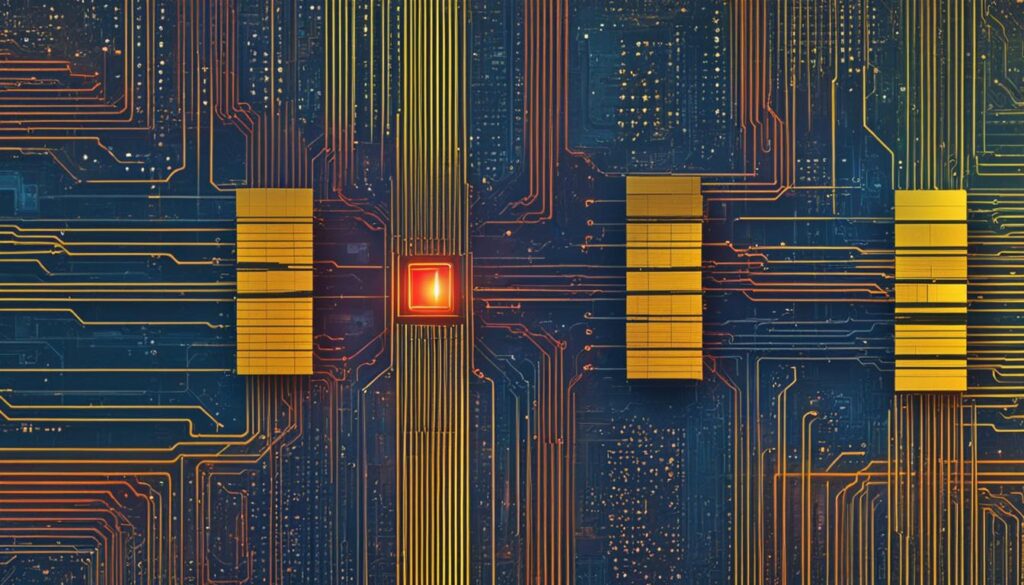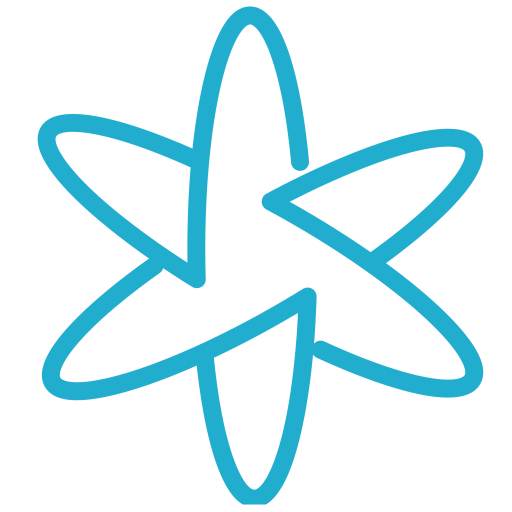Quantum computing might sound like a concept straight out of science fiction, but its cornerstone is firmly rooted in the realm of quantum mechanics. At the heart of this intriguing frontier of computation lies the qubit, also known as a quantum bit. This fundamental unit is what sets quantum computers apart from their classical counterparts.
If you’ve ever wondered, “what is a qubit for dummies?” you’re not alone. Qubit basics simplified, they’re the quantum equivalent of classic binary bits. Unlike binary bits which are limitingly binary – rigidly fixed as 0 or 1 – qubits are remarkably versatile, capable of existing in a suspended state of ‘both-and’ through a principle known as superposition.
This unique quality is what potentially enables quantum computers to tackle enormously complex tasks at astonishing speeds—far beyond what classical computers can achieve.
For those diving into understanding qubits for beginners, it’s exciting to realize that these particles are the vanguards in a revolution of processing power.
They encrypt, compute, and communicate in ways that can redefine sectors across the board. This easy explanation of qubits is just the tip of the quantum iceberg, but it opens a gate to appreciating the profound implications quantum computing holds for the future.
Key Takeaways
- Qubits perform quantum computations by taking advantage of quantum superposition and entanglement.
- Unlike classical bits, qubits can simultaneously exist in states 0 and 1, enhancing computational efficiency.
- Understanding qubits is fundamental to recognizing the potential of quantum technology in diverse applications.
- Qubit basics simplified make this seemingly complex topic approachable for beginners.
- Real-world quantum advancements are leveraging these properties of qubits to solve previously insurmountable problems.
Discover the World of Quantum Computing
As we stand on the brink of a new era in computation, it is essential to understand the monumental shift from classical computing to the quantum realm. Quantum computing represents not just an incremental improvement, but a paradigm shift in our approach to data processing and problem-solving.
The Quantum Leap from Classical Bits to Qubits
In the realm of quantum computing, the bit’s quantum counterpart, the qubit, emerges as a pivotal player. While a classical bit is akin to a switch that can be either on or off, a qubit is far more complex.
If you’ve sought a qubit definition for dummies, imagine a sphere where any point on the surface represents the state of a qubit—a vast leap from the binary nature of classical bits. This leap embodies the principle of quantum superposition, which allows qubits to exist in multiple states simultaneously, a concept central to the newfound prowess of quantum computing.
How Qubits are Revolutionizing Computing
The revolutionary superposition principle enables quantum computers to process a multitude of possibilities concurrently. This is a game-changer for sectors like pharmaceuticals, where it could expedite drug development, or logistics, with the potential to optimize complex systems in ways previously unimaginable.
Furthermore, quantum entanglement, the spooky connection between qubits that transcends space, sets the stage for advancements in secure communications and precision measurements. These properties of qubits are complex, yes, but when explained in simple terms, they reveal how quantum computing could radically transform our world.
The power of quantum computing lies in harnessing these extraordinary capabilities of qubits. As understanding deepens and technology progresses, we step closer to realizing the full spectrum of quantum computing’s potential—ushering in what could be the most significant computational leap since the invention of the microprocessor.
Breaking Down the Basics: What is a Qubit for Dummies
When venturing into the quantum computing world, a fundamental step for beginners is understanding qubits for beginners. Traditionally, digital computers rely on bits—binary units that facilitate today’s world of technology and information. Dipping our toes further into this concept, we will see how qubit basics simplified demystify the quantum leap from classical computing to the quantum frontier.
Explanation of classical bits (0s and 1s)
Classical computing is built on the simple premise of bits, represented by 0s and 1s. This binary system has served as the backbone of computing, with every operation boiling down to these two states, similar to a light bulb that is either switched on (1) or off (0). Simple, yet effective, bits are the essence of instructions in every classical computer program we run today.

How qubits differ from classical bits
Qubits, however, are clearly distinguishable from their classical counterparts. They take advantage of quantum superposition, allowing them to represent a 0, a 1, or both simultaneously.
This is not merely switching between states; it’s more like spinning a coin and only reading the outcome when it lands. This superposition state is what gives qubits their exponential processing power and underlies the quantum computers’ potential to resolve complex problems which are out of reach for classical systems.
Moreover, qubits can be entangled, a phenomenon that defies classical intuition, wherein two or more qubits exhibit a deep connection. An action performed on one entangled qubit affects the others, regardless of the physical distance separating them.
This interlinking of qubits not only contributes to the massive parallel computational abilities but it is also the cornerstone of futuristic technologies such as secure quantum communication.
In the landscape of quantum computing, understanding these distinctive properties of qubits— superposition and entanglement—is indispensable. It is this fundamental distinction that allows individuals to commence the journey towards qubit basics simplified, paving the way to a greater grasp of the intricate, yet profoundly impactful world of quantum computation.
Qubits Explained in Simple Terms: Superposition and Entanglement
Delving into the world of quantum computing, two pivotal concepts that form the basis of qubit functionality are superposition and entanglement. These are not just abstract ideas; they are properties that grant quantum computers their unparalleled capabilities, setting them apart from our everyday classical computers. For those seeking an easy explanation of qubits, here is a look at these features developed for easy understanding.
Superposition: A Qubit’s Ability to Be in Multiple States Simultaneously
At its core, superposition allows a qubit to defy the classical rules of being in a single state. Unlike a traditional computer bit that must be either a 0 or a 1, a qubit can exist in both states at once. Imagine it as the capability to process an entire spectrum of possibilities at the same time. This property is not just about “switching” between options, but about encompassing a continuum of potential outcomes.
Superposition significantly expedites problem-solving as it enables quantum computers to assess and operate on multiple computations simultaneously.
For example, while a classical computer solves a problem step by step, a quantum computer with qubits in superposition is akin to looking at all the steps at once. This vastly enhances processing speed and computational volume, addressing issues that once seemed insurmountable.
Entanglement: The Mysterious Quantum Link Between Qubits
Entanglement is often included in discussions of “what is a qubit for dummies” due to its seemingly mystical nature. It’s a quantum phenomenon where two qubits become interconnected so that the state of one instantaneously influences the state of the other, no matter the distance apart.
This “spooky action at a distance,” as Einstein famously called it, is not only fascinating but it’s at the heart of quantum communication and the high precision of quantum sensors.
Performing an action on one entangled qubit affects its partner. This aspect of quantum mechanics is instrumental in creating secure communication channels that cannot be compromised without detection and in linking quantum computers to enhance their collective power.
To succinctly summarize these concepts, superposition and entanglement constitute the very mechanics that could empower quantum computers to solve problems in seconds that our current computers might not solve in years. It’s this astounding leap in capability that underscores the true potential of future technologies powered by quantum computing.
Uncommon Insights About Qubits
Peering through the quantum looking glass, we encounter qubits not just as fundamental units of quantum computers, but as vessels carrying the enigmatic properties of quantum mechanics. The quest for a user-friendly qubit definition for dummies often overlooks the astonishing traits and historical milestones of these tiny powerhouses.
Lesser-Known Facts About Qubits
Veiled in the shadow of their own mystery, qubits harbor special characteristics that separate them from their classical precursors. For the uninitiated seeking qubit basics simplified, it may come as a surprise that the power of these quantum bits derives not from mere speed, but from the extraordinary realms of quantum phenomena they unlock.
Unique properties of qubits not widely known
While superposition and entanglement are household terms in the quantum community, the operational diversity of qubits is less known. Photonic qubits, for instance, alleviates the need for the frigid near-zero temperatures required by some of their counterparts, operating comfortably at room temperature and integrating seamlessly with existing telecommunications infrastructure.
Interesting historical facts or anecdotes
Quantum computing’s lineage can be traced to the visionary physicist Richard Feynman, who in 1981 conceived the very idea that led to the first quantum algorithms devised by Peter Shor in 1994. This historical tapestry weaves together curious instances of quantum intrigue, such as the ongoing debate of the measurement problem, a phenomenon so elusive that it still begets more questions than answers within the scientific community.
As we recognize the rich tapestry of their past and the uncharted potential of their future, qubits stand not just as objects of computational power but as symbols of scientific curiosity that push the boundaries of what is conceivable.

The Creation of Qubits: Manipulating Particles for Quantum Advantage
Qubit explained in simple terms often leaves one fascinated by the intricacies of quantum physics. A qubit, or quantum bit, stands at the crux of quantum computing—it’s the fundamental information unit, representing both 0 and 1 in a superposed state, which grants quantum systems their computational advantage. But how are qubits crafted? The process is a complex dance of physics and engineering to endow particles like ions, photons, or electrons with quantum capabilities that transcend classical computing’s limitations.

When considering what is a qubit for dummies, one must delve into how these particles are manipulated into qubits. It’s not just a simple switch but a delicate task of maintaining the particle’s quantum state through controls that are rapidly evolving as the field of quantum computing matures. Various methods exist, each with its unique challenges and approaches to preserving the integrity of superposition and entanglement.
| Type of Particle | Method of Creation | Key Benefit | Primary Challenge |
|---|---|---|---|
| Photons | Entanglement through special crystals or quantum dots | No need for extreme cooling | Sensitivity to environmental interference |
| Electrons | Utilizing the spin of electrons in magnetic fields | Fast manipulation | Decoherence from nearby electromagnetic fields |
| Ions | Contained in electromagnetic traps and manipulated with lasers | Long coherence times | Complexity in isolating and addressing individual ions |
The production of qubits is more than a scientific curiosity; it’s the cornerstone of leveraging the quantum realm for practical technologies. The performance of quantum computers depends heavily on the quality of qubits. Thus, understanding the creation process is paramount for those yearning to grasp this technological marvel and, in doing so, glimpse the future landscape of computing.
- Qubits enable quantum computers to perform complex problem-solving tasks that classical computers cannot.
- Each qubit type has unique features that necessitate different creation methods and usage scenarios.
- The stability of a qubit’s quantum state is crucial for the practicality and effectiveness of a quantum computer.
- Advances in particle manipulation are continuously expanding the horizons of what quantum computing can achieve.
In essence, the creation of a qubit is a fine balance between fundamental science and ingenious engineering—a symphony entwining the laws of quantum mechanics with cutting-edge technology to usher in the next wave of computational evolution.
The Types of Qubits: Superconducting, Trapped Ion, and Photonic Qubits
In the fascinating spectrum of quantum computing, a crucial aspect for those interested in understanding qubits for beginners lies in the diversity of the qubits themselves. Each type of qubit—superconducting, trapped ion, and photonic—carries its own set of advantages and idiosyncrasies.
These features are what fuels the research and development in quantum technologies, moving us closer to a future where quantum advantage is not just theoretical but a tangible asset in computation.
Superconducting Qubits: Speed and Scale in Quantum Processing
Superconducting qubits, widely recognized for their application in powerful quantum processors such as Google’s Sycamore and IBM’s Eagle, capture the interest of experts and beginners alike. Offering incredible speed, these qubits are a testament to the rapid advancements in quantum technology. However, the need to operate at temperatures near absolute zero presents a significant challenge, emphasizing the delicate balance between scaling up and maintaining qubit coherence.
Trapped Ion Qubits: Stability and Interaction in Quantum Systems
Forging another path are the trapped ion qubits. Renowned for their impressive stability and interaction capabilities, they harness the power of ion traps technology. Companies like IonQ and Quantinuum have embraced this type, leveraging the longevity and reliable superposition states to carve out their niche in quantum computing. Such qualities make trapped ion qubits valuable assets ready to take on complex computational tasks.
Photonic Qubits: Quantum Networking and Communication
As the world gears up for the advent of quantum networking, photonic qubits emerge as key players. These qubits, operational at room temperature, epitomize simplicity in integration with existing technologies, such as fiber-optic cables used in telecommunications—making them prime candidates for the future quantum internet. With quantum computing pioneers like Xanadu at the helm, photonic qubits stand at the forefront of quantum communication research.

The revelations in this section provide an easy explanation of qubits in terms of their types, functions, and practical applications.
It lays a foundation not just for the curious novice but also for anyone who aims to deepen their comprehension of how these quantum bits could lead us into a revolution in information processing. As a pillar of quantum technology, a solid grasp on the concept of qubits helps demystify the entire domain, paving the way for innovation and incredible scientific progress.
Understanding Quantum Mechanics Through Qubit Properties
Exploring the vast landscape of quantum mechanics can seem daunting, but by examining the inherent properties of qubits, we can simplify complex concepts and gain a clearer understanding. For a qubit explained in simple terms, think of it as more than just a binary particle; it’s a fundamental quantum system that operates under rules that challenge classical physics.
The oddity begins with the principle of superposition, where, unlike a conventional binary bit that is either 0 or 1, a qubit can be both 0 and 1 simultaneously. This principle amplifies the computational power by enabling quantum computers to handle multiple calculations concurrently—a feat unattainable by traditional computing.
Entanglement is another cornerstone of quantum mechanics reflected in qubits. This characteristic interlinks two qubits, making the state of one directly influence its entangled partner, no matter the distance. This mysterious link, which Einstein himself referred to as “spooky action at a distance,” allows instantaneous communication and forms the backbone of proposed quantum networking systems.
The curious behavior of qubits underpins another fascinating quantum mechanical concept: wave-particle duality. This underscores how particles like photons can act both as particles and waves—a fundamental trait leveraged by qubits.
The entangled photons in photonic qubits can carry quantum information over vast distances, functioning as potential pathways towards a quantum network.

Qubit basics simplified yields that the real magic happens during the act of measurement. According to the Schrödinger equation’s wavefunction, until a qubit is measured, its exact state is a blend of possibilities. The measurement forces the qubit to ‘collapse’ into one of the definite states: 0 or 1. This phenomenon is a significant aspect of quantum mechanics that distinguishes it from classical theories, involving the probabilistic nature of particle states.
To illustrate these principles in a structured manner, consider the following table that aligns the properties of qubits with their implications in quantum mechanics:
| Quantum Property | Implication in Quantum Computing | Real-world Application |
|---|---|---|
| Superposition | Enables concurrent processing of multiple states | Complex problem-solving |
| Entanglement | Instantaneous state correlation between distant qubits | Quantum networking and secure communication |
| Measurement | Collapse of the wavefunction to a definite state | Quantum sensing and metrology |
Embracing the qubit definition for dummies, one can appreciate that quantum computing isn’t merely about doing things faster; it’s a paradigm shift in information processing.
The principles highlighted above are not just theoretical musings; they are observable, experimentally validated phenomena that give a tantalizing peek into future capabilities.
The significance of these qubit properties in quantum computing cannot be understated—they are not merely academic curiosities but vital components that could redefine the trajectory of technology. As research unravels the deepest mysteries of quantum mechanics, the vast potential of qubits continues to be untapped, heralding a future laced with computational innovations thought impossible until now.
Misconceptions and Clarifications
Quantum computing frequently encounters a vortex of misconceptions, often tied to its complex nature and the nebulous realm of quantum mechanics. Addressing these misunderstandings not only enriches the comprehension of the curious learner but is vital in delineating the realistic capabilities and future prospects of quantum technologies. Navigating through these convolutions, let’s unpack the truths and myths about qubits, and in doing so, provide a clearer picture of their role in this computational revolution.
Clarifications to Enhance Understanding
As we unravel the intricacies of quantum computing, it’s crucial to recognize that qubits are not just swifter versions of bits. Their quantum properties, like superposition and entanglement, bestow upon them capabilities beyond speed, enabling them to process complex computations that are out of reach for classical bits. Advancements in error correction and algorithm optimization are continually improving quantum computing’s accuracy, moving the technology from theory to tangible applications.
Common Misconceptions About Qubits
One prevalent belief is that quantum computing will entirely replace traditional computing. However, this is not the imminent future. Instead, quantum and classical computing are projected to coexist, with quantum systems being reserved for problems beyond the scope of classical solutions.
Moreover, though errors in quantum calculations are a challenge, they do not render the state of quantum computing faulty as a whole; rather, they present a dynamic field of ongoing exploration and enhancement.
Understanding qubit definition for dummies and what is a qubit for dummies calls for this nuanced approach to dispel myths and recognize the transformative potential of quantum computing, without inflating expectations beyond the current scientific and technological advances.

The journey to demystify qubits is ongoing and fascinating. With each clarification, the veil over quantum mechanics lifts slightly, promising a future woven with the threads of complex computation and revolutionary technologies yet to unfold.
Conclusion
In summary, the exploration into the essence of qubits has illustrated their pivotal role in the ascent of quantum computing. These quantum bits provide a radically different and potent method for data processing that could surpass the capabilities of existing computational technology. While classical computers operate within a clear-cut domain of zeros and ones, qubits thrive in the probabilistic and inter-connected landscape of quantum mechanics.
Understanding qubits for beginners is crucial for appreciating the evolutionary trajectory of quantum computing. An easy explanation of qubits reveals their ability to bootstrap profound changes across various fields, from cybersecurity to drug development. As research progresses, the quantum realm promises to unlock solutions for challenges that today’s computers could spend an eternity attempting to resolve.
For those enticed by the allure of quantum computing and its foundational qubit, the journey is only beginning. The field beckons with the promise of knowledge and innovation, inviting inquisitive minds to delve deeper into its depths. Now is an opportune time to lay the groundwork for understanding, as we witness the infancy of a technological revolution that could redefine the future.
Further Reading and Educational Resources
Individuals seeking to extend their exploration of quantum computing can do so through a multitude of available resources. Enriching one’s comprehension of how qubits function within quantum systems is attainable through accessible technical articles, educational guides, and textbooks penned by experts in the field. These resources are designed to scaffold your knowledge from the basic principles of quantum mechanics to intricate quantum compute methodologies.
Visualize the Quantum World through Videos and Documentaries
For those who favor a visual approach to learning, numerous documentaries and explanatory videos offer a deeper understanding of qubits. These engaging formats bring to life the peculiar behaviors of quantum particles, making the nuances of superposition and entanglement more tangible. Coupled with expert commentary, they can illuminate the paths traversed by scientists and engineers to harness the counterintuitive nature of quantum mechanics for computational advancements. Through these visuals, one’s grasp of the bold new world of quantum technology grows more solid with each viewing.
FAQ
What is a qubit for dummies?
A qubit, short for ‘quantum bit’, is the basic unit of quantum information in quantum computing, much like bits are for classical computing. However, unlike a bit which can be only 0 or 1, a qubit can be in a state of 0, 1, or both simultaneously through a property called superposition.
How do qubits differ from classical bits?
Qubits differ from classical bits in their ability to be in multiple states (0 and 1) at the same time due to quantum superposition. Furthermore, they can be entangled with other qubits, meaning the state of one qubit can instantly influence another, regardless of distance – a behavior not found in classical bits.
How are qubits revolutionizing computing?
Qubits are revolutionizing computing by enabling quantum computers to process vast amounts of possible solutions simultaneously, significantly speeding up complex problem-solving in areas such as cryptography, materials science, and drug discovery. Their unique properties of superposition and entanglement allow them to perform operations that are impractical for classical computers.
What are classical bits (0s and 1s)?
Classical bits are the smallest units of data in classical computing. They can be in one of two definite states: 0 or 1, which correspond to off or on states, similar to a light switch. All classical digital data and processing are built upon combinations of these bits.
What is superposition in simple terms?
Superposition is a quantum property that allows a qubit to exist in a combination of the states 0 and 1 at the same time, instead of being limited to a single state as classical bits are. This means a qubit can perform multiple calculations simultaneously, which is what gives quantum computers their potential power.
What is entanglement in qubits?
Entanglement is a quantum phenomenon where two or more qubits become interconnected in such a way that the state of one qubit can directly affect the state of the other, no matter how far apart they are. This property can lead to faster information processing and secure communication protocols that exploit these quantum links.
Can you share some lesser-known facts about qubits?
One lesser-known fact is that qubits do not always require extremely low temperatures to operate; some, like photonic qubits, can function at room temperature. Also, the concept of quantum computing was proposed by Richard Feynman in 1981, which shows how long the idea has been developing before becoming a reality.
How are qubits created?
Qubits are typically created by isolating and controlling subatomic particles, like electrons, photons, or ions, and using precise methods to induce the properties of superposition and entanglement. These methods include applying magnetic fields, using lasers, or employing microwave radiation to manipulate the states of these particles.
What are the different types of qubits?
There are several types of qubits, including superconducting qubits, which are common in many quantum processors and operate at incredibly low temperatures; trapped ion qubits, which have long coherence times and are known for their accurate quantum state control; and photonic qubits, which can work at room temperature and are promising for quantum communication.
What are some common misconceptions about qubits?
A common misconception is that qubits are just faster classical bits when, in fact, they operate under entirely different principles due to their quantum nature. Another misconception is that quantum computing will soon replace classical computing, whereas it’s more likely that the two will work in tandem, with quantum computing handling specific types of problems more efficiently.
